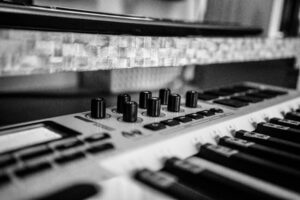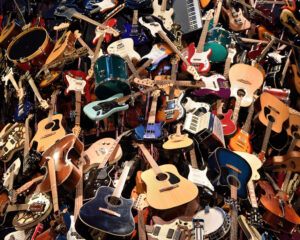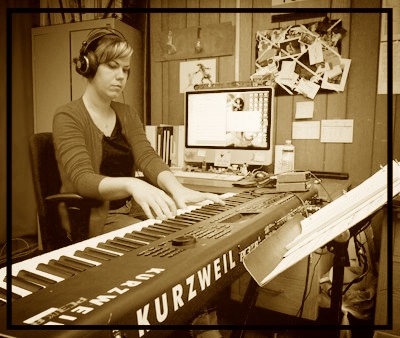I have been a musician for almost my entire life. At four years old, I could sing every word of Annie without skipping a note. When I was in the third grade, I got a piano for my birthday and started the first of many private lessons. In the fourth grade, I started playing the viola in my school orchestra. I don’t usually count that as one of my instruments because, in orchestra class, I was more interested in talking to my best friend, who played the cello and sat right next to me. Because of this, I never learned how to read alto clef fluently, and so I faked the viola until I was in the 7th grade and had to quit when my rouse caught up with me. In the 6th grade, I started playing flute and piccolo in the school band. In the 8th grade, the jazz band needed a tenor saxophone player, so I did that for a year since it was a smooth transition from the flute. Somewhere in middle school, my dad got me a Fender California Series acoustic guitar, and in high school, he got me a Gibson SG. I can play the guitar well enough to be entertaining at a campfire. I was a music major in college, and while there, I took private piano and flute lessons. Most of my music school friends were percussionists, so halfway through my college career, I started taking private percussion lessons, and somehow became the principal percussionist in Campus Band. So, as you can see, I have a pretty diverse background in music. Music has driven every of my life decisions. So why, when I started my studio recording private lessons, did I not want to play any music?
 My degree is in Commercial Music. My focus in that area was on engineering and producing. As part of this focus, I was required to write, record, and produce a song once a week. I would then have a one-hour lesson where my professor would respond to my latest creation. The expectation was that I would absorb these notes, and my next project would be better. The thing is, it took me a while to get better because I did not want to write or play my own music. For some reason, once I began the Commercial Music program, I decided I only wanted to be an engineer and producer, and I did not want to be a musician anymore. I asked my professor if I could hire musicians to play for me. I told him I would do two lessons a week instead of one; I just did not want to play anymore. He did not bend–not even a little. Then he told me something that I have never forgotten. It’s a phrase I use with my students all the time. He said, “My engineers are not just button pushers.” He is a graduate of the Eastman School of Music, and he is a fantastic trumpet player. He has a wealth of musical knowledge, so it frustrates him when sound engineers don’t feel the music the way he does. He told me a story about a sound engineer that worked for him in the past. He said this guy did not have a musical bone in his body. He was a button pusher. Mics would come on; mics would go off. That’s it. My professor decided that he did not want anyone coming out of his program to perform like that. I fought it for a while, but eventually, I gave in, and I’m glad I did. It was the best decision I ever made.
My degree is in Commercial Music. My focus in that area was on engineering and producing. As part of this focus, I was required to write, record, and produce a song once a week. I would then have a one-hour lesson where my professor would respond to my latest creation. The expectation was that I would absorb these notes, and my next project would be better. The thing is, it took me a while to get better because I did not want to write or play my own music. For some reason, once I began the Commercial Music program, I decided I only wanted to be an engineer and producer, and I did not want to be a musician anymore. I asked my professor if I could hire musicians to play for me. I told him I would do two lessons a week instead of one; I just did not want to play anymore. He did not bend–not even a little. Then he told me something that I have never forgotten. It’s a phrase I use with my students all the time. He said, “My engineers are not just button pushers.” He is a graduate of the Eastman School of Music, and he is a fantastic trumpet player. He has a wealth of musical knowledge, so it frustrates him when sound engineers don’t feel the music the way he does. He told me a story about a sound engineer that worked for him in the past. He said this guy did not have a musical bone in his body. He was a button pusher. Mics would come on; mics would go off. That’s it. My professor decided that he did not want anyone coming out of his program to perform like that. I fought it for a while, but eventually, I gave in, and I’m glad I did. It was the best decision I ever made.
 Now I’m a sound designer for theatre, and my musicianship helps inform many of my decisions. I know to push the music during a big musical swell or interlude. I know that a little reverb in the back makes a small orchestra sound more prominent and lusher. I know to fade down to underscoring, and I know to gracefully fade up to transition music. It’s not something I think about. It’s something I feel in my body, and my hands just follow. I know it’s easy for me to say though. I’m a musician, and I have been for most of my life. So what if you’re not a musician? What if you can’t read music, you’ve never touched a musical instrument, but you are a sound engineer? You don’t have to be a musician to be musical. You don’t have to be a musician to feel the music in your body, and I have a few exercises to help bring the music out of a non-musician’s soul.
Now I’m a sound designer for theatre, and my musicianship helps inform many of my decisions. I know to push the music during a big musical swell or interlude. I know that a little reverb in the back makes a small orchestra sound more prominent and lusher. I know to fade down to underscoring, and I know to gracefully fade up to transition music. It’s not something I think about. It’s something I feel in my body, and my hands just follow. I know it’s easy for me to say though. I’m a musician, and I have been for most of my life. So what if you’re not a musician? What if you can’t read music, you’ve never touched a musical instrument, but you are a sound engineer? You don’t have to be a musician to be musical. You don’t have to be a musician to feel the music in your body, and I have a few exercises to help bring the music out of a non-musician’s soul.
First, make playlist of ten songs. These should be some of your favorite songs, and if they’re contrasting genres, even better. Next, get some headphones, and head to a quiet room where you can be alone. If it doesn’t creep you out too much, turn off the lights. Now put on your headphones, and listen to your entire playlist. Note the parts that give you the warm fuzzies, or make the hair on your arms stand up, or force tears to flow from your eyes. What is happening musically in those moments? Did the instruments crescendo? Was there a vocal effect? Did the reverb ring out after the final note? What about that music made it an experience as opposed to an exercise. Remember that stuff, and carry it with you into your next gig.
After you’ve done the headphones task, do it again, but this time listen through the best speakers you have access to. Even if that’s in your car, that’s ok. Listen to the same playlist, and remember those spots you loved. Keep your hand on the volume knob, and gently follow the musical line. Turn up the volume slightly with that swell. Fade it back down when the line does. This will start to help you attach your warm fuzzy feelings to your technical hands. This is an exercise I love, so I always encourage people to do make multiple playlists and practice this regiment often. It really does help train your brain and your body to work together.
Another great exercise I like to have my interns and students work on is shadow mixing a movie. My suggestion is to choose a few movie musicals like Les Miserables, Moulin Rouge, or literally any Disney movie. Now, sit on your couch, and put 8 pennies on the coffee table in front of you. For the first movie, keep your pointer and middle finger on your right hand on two of those pennies. Those are your music faders. Just like the volume knob exercise, move those penny faders with the music. If you want to add a level of precision, mark a piece of paper with decibel markings to put under the pennies and keep track of the relationship of your pennies to unity. Do not note things like “Now I am at -10, now I am at -12.” Once you start relying on the numbers, you stop using your ears, and they are your most valuable tool. The muscle memory and relationship between your ears and fingers is what is most important. After you’re comfortable with the music, watch the movie again, and this time, assign characters to the other 6 faders. This part you will probably have to practice scene by scene, and if there are more than 6 characters per scene, you can assign groups to one DCA, or penny, in your case. So now, you just repeat the process but adding vocals. When you hear voices get big, follow them with your pennies, and keep doing what you were doing on the first round with the music. If you’re going scene by scene, try filming your hands, and repeat the scene twice. Do your hands have basically the same relationship each time? Are there long stretches of time where you have forgotten to consider music changes? Review the footage, and repeat the practice. The next time you are mixing or designing a show, you just might find that your natural inclination will now be to enhance the musical line with subtle fader movements, thus giving an otherwise flat sound some body and life. This will be the difference between an acceptable show and an impressively beautiful show.
